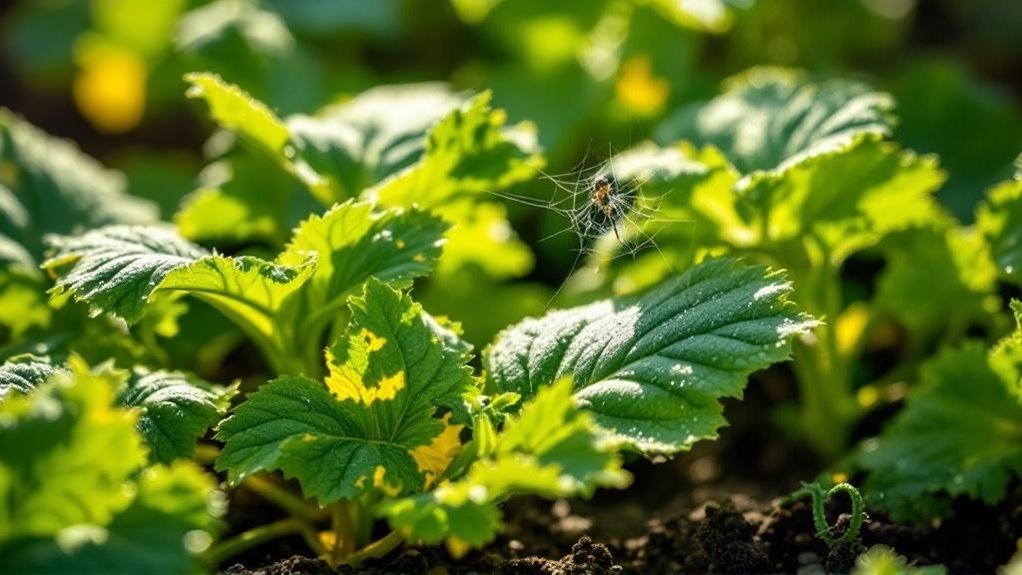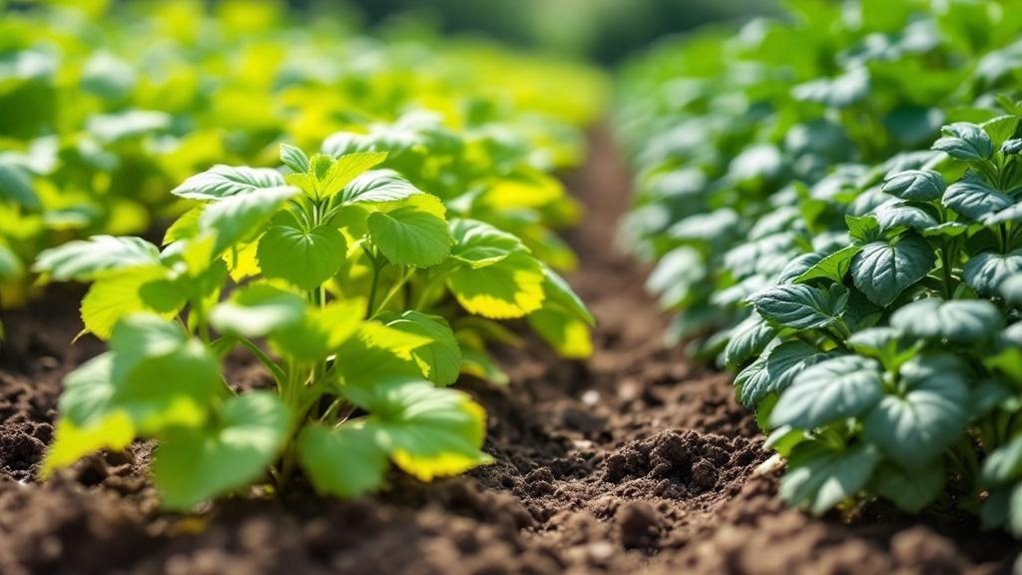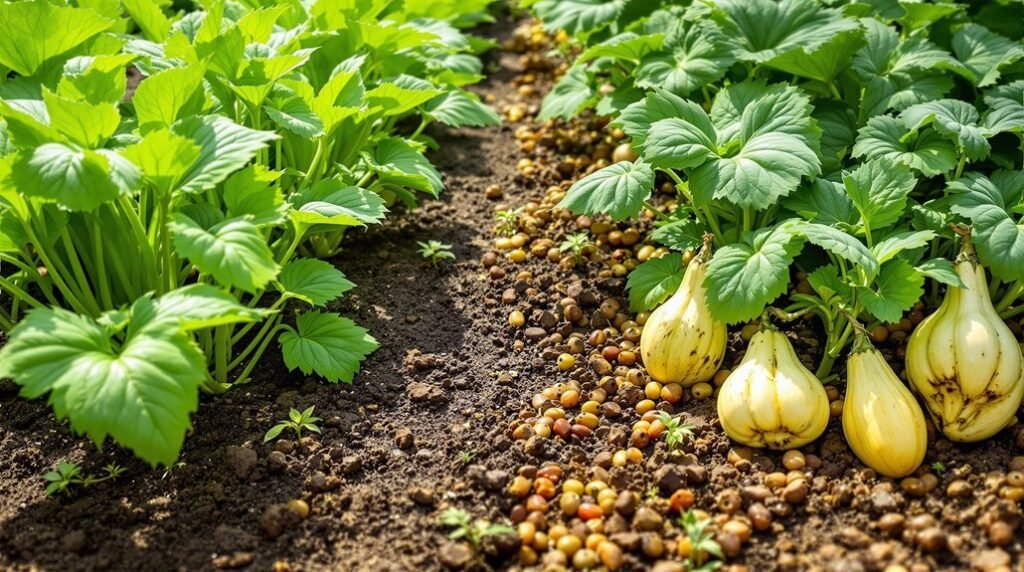You notice yellowing leaves, you spot scorching edges, you find browning tips—each could signal a nutrient deficiency in your garden. Learning to recognize these visual cues helps you address problems before they worsen. But which symptoms point to which deficiencies? Understanding these signs across different plants is key to keeping your garden healthy and productive.
Common Nutrient Deficiencies in Alfalfa and Berries
While both alfalfa and berries require a balanced nutrient supply, you’ll often see similar deficiency signs that can signal trouble.
Potassium deficiency typically shows as scorching along the leaf margins in both plants.
Boron deficiency affects the youngest leaves, causing abnormal growth and stunted growth at the terminal shoots.
Calcium deficiency is more obvious in berries, where you’ll notice browning and dieback at the growing root and leaf tips, though it’s less pronounced in alfalfa.
Zinc deficiency mainly impacts berries, creating a banding or striping pattern on new leaves and leading to stunted growth.
Recognizing these visual symptoms early helps you address nutrient gaps promptly, protecting your alfalfa and berry crops from yield loss and poor health.
Stay vigilant for these signs to maintain a thriving garden.
Nutrient Deficiency Symptoms in Cereal Grains and Corn
Just as nutrient imbalances show distinct signs in alfalfa and berries, cereal grains and corn display their own telltale symptoms when lacking key nutrients.
Nitrogen deficiency causes stunted growth and pale, yellowish-green leaves, with older leaves showing chlorosis first.
Phosphorus deficiency stunts plants and distorts leaf shape, often turning lower leaves and stems purple or reddish.
Potassium deficiency leads to scorching along leaf margins, harming overall plant health.
Zinc deficiency appears as banding or striping on new leaves and also causes stunted growth.
Recognizing these signs helps you address nutrient gaps early.
Paying attention to leaf color and growth patterns, especially the yellowish-green hues and chlorosis, guarantees your cereal grains and corn thrive with proper nutrient balance.
Visual Indicators of Deficiencies in Cucurbits and Fruiting Vegetables

When you spot scorching along the leaf margins of your cucurbits, potassium deficiency is likely the cause.
Visual nutrient deficiencies in cucurbits and fruiting vegetables often show distinct signs.
Calcium deficiency leads to browning and dieback at growing root and leaf tips, severely impacting plant health.
Magnesium deficiency causes interveinal chlorosis on older leaves, making them brittle or thin.
Boron deficiency results in abnormal growth on the youngest leaves and stunted terminal growth, hindering overall development.
Zinc deficiency is marked by banding or striping on new leaves, accompanied by stunted growth.
Recognizing these visual clues—scorching, chlorosis, leaf tip damage, banding, and stunted growth—helps you identify and address nutrient deficiencies in your cucurbits and fruiting vegetables promptly.
Recognizing Nutrient Deficiency Signs in Grapes and Leafy Vegetables
Although nutrient deficiencies often present subtle symptoms, recognizing them early in grapes and leafy vegetables can save your plants from severe damage. For example, nitrogen deficiency shows as pale, yellowish-green foliage mainly on older leaves, while calcium deficiency causes browning and dieback at growing tips. Potassium deficiency triggers scorching along leaf margins, and boron deficiency affects the youngest leaves and terminal growth in grapes. Zinc deficiency produces banding on new leaves, reducing plant growth.
| Deficiency | Key Symptoms | Affected Area |
|---|---|---|
| Nitrogen | Yellowing, stunted growth | Older leaves |
| Calcium | Browning, dieback | Growing root & leaf tips |
| Potassium | Leaf margin scorching | All leaves |
| Boron & Zinc | Abnormal growth, striping | Youngest leaves, terminal growth |
Use visual diagnosis to catch these symptoms early and guarantee healthy plant growth.
Identifying Deficiencies in Potatoes and Soybeans

Nutrient deficiencies in potatoes and soybeans often show specific symptoms that can help you diagnose problems early.
In potatoes, potassium deficiency causes scorching along leaf margins, reducing tuber quality and yield. Calcium deficiency leads to browning and dieback of growing root and leaf tips, impacting root development and overall plant health.
Soybeans with boron deficiency display stunted growth and abnormal development on the youngest leaves, while manganese deficiency appears as gray spots and brown dead areas on lower leaves, affecting photosynthesis.
Both crops may show zinc deficiency through a striping appearance on new leaves, accompanied by chlorosis and stunted growth.
Recognizing these deficiency symptoms allows you to address nutrient issues promptly, ensuring healthy growth and better crop production in your garden.
Nutrient Deficiency Patterns in Tree Fruit
If you want your tree fruit to thrive, spotting nutrient deficiencies early is crucial.
Calcium deficiency often causes browning and dieback at growing root and leaf tips, while potassium deficiency shows scorching along leaf margins.
Boron deficiency leads to stunted growth and abnormal development on the youngest leaves, reducing fruit production.
You might notice manganese deficiency as gray spots on lower leaves, which can turn into brown dead areas if severe.
Zinc deficiency reveals itself through banding or striping on new leaves and causes stunted growth, impacting fruit quality.
Regular soil testing and visual assessments help you detect these issues early, allowing timely corrections to maintain tree vigor and maximize yield.
Keep a close eye on these patterns to guarantee your tree fruit stays healthy and productive.
Diagnostic Tools for Detecting Nutrient Deficiencies
When you want to catch deficiencies early, combining soil and tissue testing with visual observation gives you the best chance to diagnose problems accurately.
Soil testing reveals nutrient levels before plant symptoms appear, guiding targeted corrective measures. Tissue testing analyzes nutrient concentrations within plants but can vary by species and environment.
Visual observation quickly assesses nutrient deficiencies by noting plant symptoms, though it may confuse deficiencies with pests or diseases. For precise diagnosis, use a nutrient deficiency flow chart that categorizes symptoms by leaf age and color patterns.
These diagnostic tools enable early detection, letting you manage nutrient issues before they cause severe damage. By integrating these methods, you can swiftly identify and address nutrient deficiencies, ensuring healthier garden growth and productivity.
Frequently Asked Questions
How Often Should I Test My Garden Soil for Nutrient Levels?
You should test your garden soil every 1 to 3 years, depending on your plants’ needs. Testing more often helps you catch nutrient imbalances early and keep your garden thriving throughout the growing season.
Can Over-Fertilizing Cause Similar Symptoms to Nutrient Deficiencies?
Yes, over-fertilizing can cause symptoms like nutrient deficiencies because it disrupts nutrient balance and harms roots. You’ll notice yellowing leaves or stunted growth, so always follow recommended fertilizer amounts to avoid these issues.
Are There Natural Remedies to Correct Nutrient Deficiencies in Plants?
When push comes to shove, you can fix nutrient deficiencies naturally by adding compost, using organic fertilizers, or planting nitrogen-fixing cover crops. These methods feed your plants gently and keep your garden thriving without harsh chemicals.
How Do Weather Conditions Affect Nutrient Uptake in Plants?
You’ll find that extreme weather—like heavy rain or drought—can hinder your plants’ nutrient uptake by affecting soil moisture and root health. Temperature swings also influence nutrient absorption, so keeping conditions stable helps your garden thrive.
Can Companion Planting Help Prevent Nutrient Deficiencies?
Yes, companion planting can help prevent nutrient deficiencies. You’ll boost nutrient availability and balance soil health by pairing plants with complementary nutrient needs and root structures, improving overall garden vigor and reducing competition for crucial nutrients.
Final Thoughts
You’ll notice that healthy, vibrant leaves stand in sharp contrast to the yellowed, scorched, or striped foliage signaling nutrient deficiencies. While nitrogen’s pale, stunted leaves whisper a silent warning, potassium’s burnt edges shout for attention. Calcium’s browning tips and boron’s twisted new growth paint a picture of imbalance. By spotting these signs early, you can transform your garden from struggling patches to flourishing greenery, ensuring every plant reaches its full potential.
